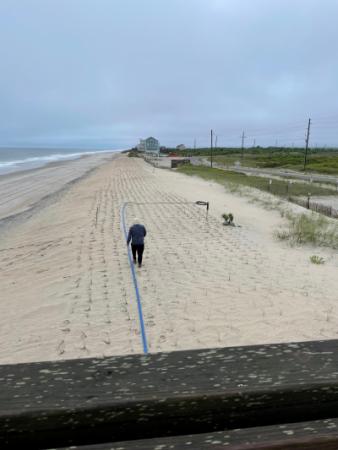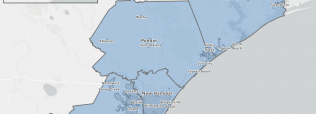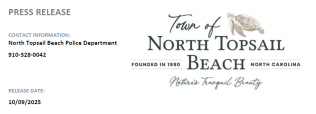Sea Oats FAQ
The Town receives many inquiries about the planting of sea oats on the recently restored dunes in Town. This FAQ sheet will try to answer most of those inquires.
Question: Who is paying for the cost of the recently planted sea oats into the restored dunes?
Answer: The Town has included this cost in the FEMA reimbursement program for Hurricanes Florence and Dorian.
Question: What are sea oats?
Answer: Sea oats are in the grass family and native to the NC coast. Sea oats get their name from the flower stalks that develop in summer and look like ‘cereal grain oat seed heads’’ as illustrated in the picture above.
Question: Why are sea oats the plant of choice for restoring unvegetated dunes?
Answer: Sea oats are native with a root system that can survive the winters here on the coast. Another key feature is that as a grass growing low to the ground, sea oat stems trap blowing sand (mostly only 6 inches high above beach level) and holds it just like snow fencing along mountain roads keeps the snow from drifting across the road. As the sand piles up year after year, the sea oats stems grow longer and thus a repetitive cycle is created year after year for natural dune building.
Question: Why is it important to vegetated dunes?
Answer: Coastal Area Management Act (CAMA) rules in NC dictate that pilings (posts) for beach access cross-overs cannot be placed in unvegetated dunes. While this is an inconvenience for property owners with private cross-overs and town CAMA public accesses, stabilizing the dune as described above is the ultimate goal.
.
Question: Where were the sea oats planted?
Answer: Everywhere throughout Phases 2-4 where the dune was restored the previous two years.
Question: How many sea oats have been planted?
Answer: vegetation planting was completed in August 2022. 308,200 sprigs were planted within the Phase 5 area and 529,111 sprigs were planted in the Phase 2-4 Areas.
Each section of dune was planted by hand with roughly 30 rows of plants on 2’x2’ spacing going across the dune from the ocean side toe of the dune, up the slope, over the crest, and down to the level of the restored dune on the street side
Question: Why was my area missed?
Answer: An area may have been skipped due to sea turtle nests or obstructions. September 15 was the cutoff for planting sea oats this year. Areas that were skipped will be planted in the spring of 2023.
Question: What should people expect if they have already planted sea oats or American Beachgrass? Were those plants be replaced? Should they of been removed?
Answer: If owners had already planted sea oats to the specified density we worked around their area. If the density was less than 2x2 we supplemented the plantings. If they’ve planted American Beachgrass (Ammophila breviligulata) instead of sea oats (Uniola paniculata), we interlaced with those plants. Please never remove what’s there. That’s just a waste. Some folks are probably hoping that we will increase the density beyond 2x2 spacing. However, having too high a density is detrimental to the root/rhizome system of the plants and will cause increased die-off.
Question: Why do my plants look spindly?
Answer: New sprigs are spindly and they take a few months of growth to get big and bushy. These recent plants will not grow much in the next few months but will look good by the end of summer 2023. Costal Transplants has implemented a fertilization program for the plants and come by periodically to fertilize everything they have planted. The goal was for 90% of the plants to survive and after review in September, they are well above that statistic.
Further reading:
An excellent source of information about sea oats and sand dunes is The Dune Book by Spencer Rogers and David Nash, 2003 North Carolina Sea Grant, (reprinted in 2016). You can read an online version of the guidebook on Spencer Rogers’ North Carolina Sea Grant Program webpage at https://ncseagrant.ncsu.edu/about-us/our-team/spencer-rogers/ Please keep your beach questions coming in to the Town Manager at townmanager@northtopsailbeachnc.gov so that we can continue to update our FAQ Shoreline Protection fact sheets





